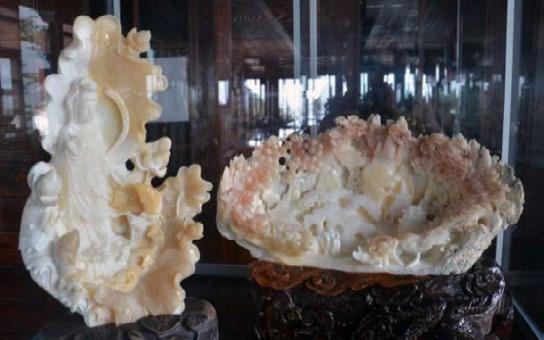
3 minute read
Background
Giant Clams - Fast Facts
They are the world’s largest shellfish.
Advertisement
There are 12 giant clam species.
The largest species Tridacna gigas can measure up to 1.3 m long and weigh up to 225 kg.
Giant clams build and shape reefs, filter water, and provide food and shelter for other reef creatures.
They are hermaphroditic, but not self-fertilising – they depend on other individuals in their proximity to reproduce.
Giant clams are native to the tropical waters and shallow coral reefs of the Pacific Ocean, Indian Ocean, South China Sea, and the Red Sea. There are 12 known giant clam species of varying geographical ranges, with the highest diversity of species occurring in the Coral Triangle marine area, which includes the waters of Indonesia, Malaysia, the Philippines, Papua New Guinea, Timor-Leste, and the Solomon Islands.7
Harvesting giant clams has been a traditional activity of coastal communities across the Asia and Pacific regions for thousands of years, with the soft clam body a source of subsistence or ceremonial food and the large shells a useful material for a range of purposes. Due to their abundance, shallow distribution, and immobility, it was relatively easy to collect them.
Giant clam harvesting for commercial purposes and illegal offtake by long-range foreign vessels increased dramatically during the 1970s as new markets developed: rising demand for the meat as a high-value delicacy in parts of East Asia and Europe, live giant clams for the international aquarium trade in Europe, United States, Australia, and Japan, and more recently, shells for the ornamental carving industry in China.8 This has resulted in the overexploitation of giant clams and declining populations throughout much of their range.
The most sought-after species in trade are the true giant clam Tridacna gigas (see Image 6), southern giant clam Tridacna derasa, fluted giant clam Tridacna squamosa, and the maxima clam Tridacna maxima. The world’s largest giant clam species T. gigas is the most threatened, with about half of its wild populations either severely decimated or locally extinct at some sites.9
Image 6: Tridacna gigas, true giant clam. Credit: Insight Philippines.
7 https://www.sciencedirect.com/science/article/pii/S0006320714004212 - in addition to the 12 known species there is also an undescribed cryptic species. 8 https://www.tandfonline.com/doi/full/10.1080/09614524.2018.1467378 9 https://www.sciencedaily.com/releases/2017/12/171211120442.htm
In response to the surge in international commercial trade of giant clams, in 1983 two species (T. gigas and T. derasa) were listed in Appendix II under CITES.10 Two years later the listing was expanded to the whole Tridacnidae family (now classified as the Tridacninae subfamily), covering all known giant clam species. However, enforcement of CITES’ regulations for giant clams has been impeded in the past because some major players which were heavily involved in the giant clam trade, such as Taiwan and the Maldives, were not CITES Parties.11 Another issue is that CITES regulations apply to international trade, but not to local collection and domestic trade within a country, which can also occur at significant levels.
Giant clams are now protected by national legislation in most range countries. Although commercial exploitation of wild stocks is widely banned and various management efforts are being implemented such as the development of mariculture programmes, harvesting quotas and restricted fishing methods, large-scale poaching and illegal trade continue to pose a serious threat.
10 http://www.vliz.be/imisdocs/publications/340612.pdf - Under CITES Appendix II, international trade is permitted but regulated through appropriate permits/certificates. All trade in Appendix II specimens introduced from the sea is required to have a certificate issued by the CITES Management Authority of the State into which the specimens are being brought. 11 The Maldives acceded to CITES in 2012, while Taiwan is not a recognised member party of CITES.










